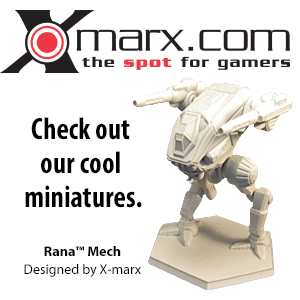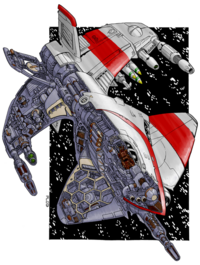Aerospace fighter
Sarna News

- HEXTECH Review - Wave 3 Brings More Urban Options To Your Battlefield
- Your BattleTech News Round-Up For March, 2024
- Crashing 'Mechs With Jennifer Brozek, Author Of The Rogue Academy Trilogy
- Getting The Word Out With Rem Alternis, Catalyst Community & Marketing Director
- Bad 'Mechs - Yeoman
- Read more →
Description[edit]
Aerospace fighters are similar to conventional fighter aircraft, but are capable of operating in both an atmosphere and in space, which makes them far more versatile. They use fast-pumping, dual-chambered fusion engines, instead of the jet or turbine engines usually employed by conventional fighters, which makes them immune to engine stalling and overall provides them with far more durability, as well as comparatively more space for their loadouts. However, they are much more expensive and use advanced technologies much harder to manufacture compared to conventional fighters and BattleMechs, which prevent them from gaining a dominant role on the battlefield.[1]
Aerospace fighters utilized much of the same technology as BattleMechs, such as using thin strands of myomer to control flight surfaces. For most, flight controls remain traditional with control sticks and touchpad screens, supported by a simple helmet-based HUD which displays basic information such as fuel, ammunition and sensor readings.[2] During high-G maneuvers, for most fighters a selection switch on the secondary control stick allows the pilot to utilize the touchpads.[2] Pilots wear neurohelmets which use their kinesthetic sense to help perform maneuvers and view their environment through a holographic heads-up display. Unlike the HUD of its terrestrial-bound cousins, aerospace fighter HUDs are bowl-shaped to account for the three-dimensional battlefield, with the center of the bowl aligned with the nose of the craft.[3] Aerospace fighters of the Star League Defense Force were much more advanced, with control of the craft literally in the hands of the pilot through special gloves which, in combination with a more advanced neurohelmet that detected neural impulses to a greater degree, allowed for much quicker and more efficient maneuvers. The HUD was also replaced with a virtual reality display covering the entire cockpit, allowing for greater amount of information to be displayed.[2] Post-3065, more Inner Sphere fighters have begun to incorporate some of this technology, such as helmets which detect subconscious signals to replace the touchpad selection switch.
Weight Classes[edit]
Aerospace fighters are divided into three categories, based on their chassis mass:
- Light aerospace fighters weigh 20 to 45 tons. Compared to the other classes, they are much more speedy and agile, which allows them to perform well in a variety of roles. They are the most flexible of the aerospace fighters.[1]
- Medium aerospace fighters weigh 50 to 70 tons. They are not as flexible as their lighter cousins, but have a blend of speed and firepower that gives them an edge in dogfights, so they are primarily employed to combat enemy air forces.[1]
- Heavy aerospace fighters weigh 75 to 100 tons. Very inflexible, the heavy fighters carry heavy weapons and armor, so they can function as heavy bombers or DropShip escorts. In groups, they can take on heavier spacecraft such as DropShips or WarShips, as against these heavy spacecraft the lighter fighters have neither the power nor the armor to stand up to them.[1]
Notes[edit]
- This article refers to a common object and addresses the object as a common noun. The preferred term is "aerospace fighter" (except on section titles & table headings, where "Aerospace Fighter" is favored).
See Also[edit]
References[edit]
Bibliography[edit]
- Lethal Heritage (novel)
- TechManual
- Total Warfare


